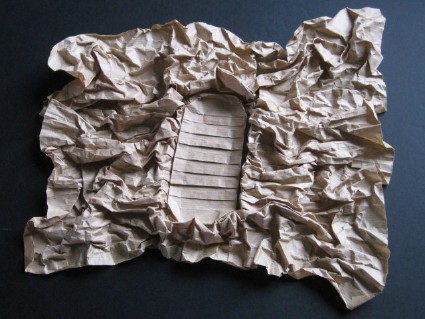
 | Welcome on MOOC-invitation |
|
| New! | An invitation to practice origami | map | Discovery of the world of folding paper From origami to the Art of Folding Paper |
| Back MOOC1 | Journey 2 | Sequence 1 | <--- page 2 | page 3 | page 4---> |
 |
Crease patterns |
| One of the first folders who noted the importance of crease patterns is probably Peter Engel, who, described in his book « Origami - From Angelfish to Zen » the patterns drawned by the first folds of traditional bases. Crease patterns (french canevas de plis) look like a graph made of straight line segments joining on a fw points. This graph represents the set of folds made after several folding steps. A simple way to get a crease pattern involves in making a folding, then unfolding entirely the sheet of paper. On can see an intricacy of mountain or valley folds, this constituting the crease pattern of this folding. For an experienced folder, a crease pattern brings two informations: - the general structure of the folding. For instance, reading the crease pattern of the traditional crane, one can recognize which parts of the sheet of paper will allow us to create the wings, the head or the tail. - an idea of the complexity of the folding, looking at the number of folds, their density and their orientation. Fold a model using a creas pattern is done through several steps: - cracking the CP. The difficulty consists in finding the position of the reference points and the angles between the different segments. Some CP are drawn on a grid easy to determine. Others give no indication, and must be treated as brain-teasers. - marking and pre-folding of the mountain and valley folds. Some CPs do not provide the type of folds. The puzzle is more complex to solve! - folding of the CP. Usually, one begins by folding the mountain folds, acompanying then little by little by the associated valley folds. The entirely solved CP is called the base. - finishing and modelling stage. This part heavily depends on the detail level of the CP. For instance, if the final object has fingers or claws, either the CP gives the folds to be made to get them, or the CP indicates only where they will be. Usually, the CP is accompanied with a picture or a photograph shwowing the entirely finished folding. The disappearance of the diagrams, and therefore the disappearance of the sequences of folds, can be an important obstacle to the practice of paper folding by the not so experienced folders. It is easy to understand the interest for the designers: - the phase of creating a diagram no longer exists, - the crease pattern is easy to get and/or to draw, - the crease pattern is a designing tool, allowing the folder to build little by little his model. Exhaustive mathematical studies have allowed the folders ro better understand the structure of foldings. During debates between creators, discussions about the style of such or such sequence of folds have given way to dissertations about the style crease pattern. Folding is no longer a problem, everybody knows how to do! |
11 photo(s)